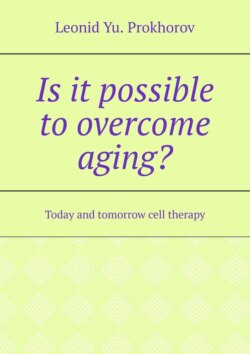Читать книгу Is it possible to overcome aging? Today and tomorrow cell therapy - Leonid Yu. Prokhorov - Страница 5
CHARACTERISTICS OF THE HUMAN SKIN AND CAUSES OF SKIN AGING
ОглавлениеThe main cellular elements of connective tissue are fibroblasts. Fibroblasts are cells of mesenchymal origin, round or elongated, spindle-shaped or with flat shape, spikes and oval nucleus (Fig. 3). The state and function of the main extracellular components of connective tissue: collagen, elastic and reticular fibers and intercellular matrix, depend on the functional activity of fibroblasts. As the result of differentiation of the fibroblasts become less active, mature cells – fibrocytes.
Fibroblasts are the main cells of the middle connective tissue layer of the skin, called derma (Fig. 4, 5). The principal function of fibroblasts in dermal skin layer is participation in metabolism of cellular substance. Fibroblasts of the skin synthesize and secrete into the environment a large number of biologically active substances, among which there are various growth factors, extracellular matrix components and enzymes. This process takes place continuously, and due to it intercellular substance is constantly replaced. Particularly intense is metabolism of hyaluronic acid (Kricheli et al., 2004). As in all other organs and tissues of the human body, there are age-related changes in the skin during the whole life.
In aging skin, the thickness of the dermis decreases, the moisture content in it falls, and as a result of this process the skin loses elasticity. The consequence is the formation of wrinkles. Aging of the skin in different parts of the body proceeds unevenly. Particularly rapid is the aging of exposed skin. The reason for this, as described above, is photo aging (because of exposure to sunlight), as well as atmospheric effects. At the same time, age-related skin changes are less pronounced in covered areas.
It is believed that one of the main causes of skin aging is a decrease in the ability of skin fibroblasts to divide with age. As a result of this process, the number of fibroblasts in the skin decreases, and they become less active. Therefore, if to stimulate proliferative and synthetic activity of fibroblasts, in any way, then it will be possible to improve skin conditions (Krikheli et al., 2004).
In addition, in the skin there occurs a decrease of the amount of collagen fibers and their hydration, they lose the ability to swell and become rigid; as a result the turgor is decreased, and wrinkles appear. At the same time, the skin loses lipids, its protective mantle breaks down, and it becomes vulnerable to disruption (Guide of gerontology, 2005).
As the number and activity of fibroblasts is reduced, the remaining cells are unable to compensate for senile changes in the skin. Therefore, if to increase the number of young active fibroblast cells in the skin, it is reasonable to wait for the improvement of its condition due to the fact that fibroblasts will produce young collagen and elastin, and this will increase the elasticity of the skin and its turgor; as a result, the wrinkles well be smoothed.
